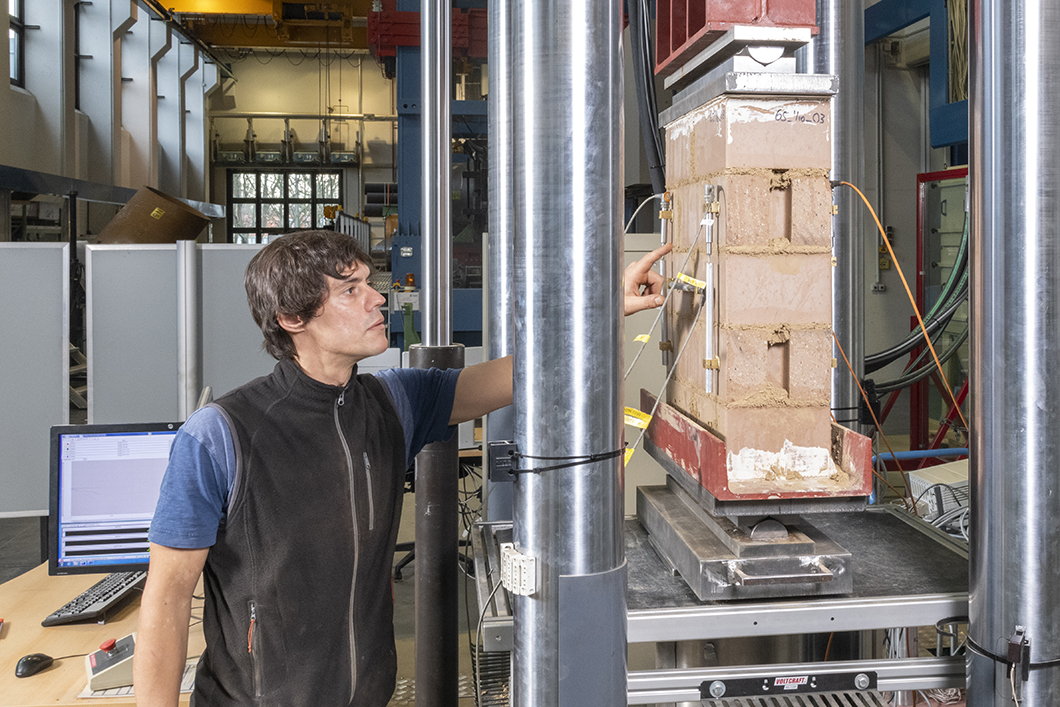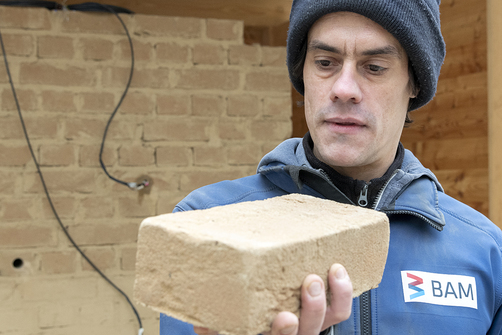
Philipp Wiehle investigates the mechanical properties of earth masonry
Source: BAM
Earth has been used for thousands of years. BAM is currently investigating the properties of earth masonry and earth mortar made of for use in sustainable housing construction. The aim: the material shall be included in the relevant application standards.
Building is a major cause of the emission of the greenhouse gas CO2. Constructing houses and other buildings in a sustainable and climate-neutral way is therefore an imperative of common sense. "Building materials made of earth could play an important role in this," says Philipp Wiehle. The civil engineer is involved in a research project that is investigating the strength, deformation and other physical properties of earth blocks and mortar. The project is funded by the Deutsche Bundesstiftung Umwelt (DBU).
Excellent CO2 balance
The basic prerequisites of earth for climate-neutral and sustainable building are excellent: The material - simple earth with a proportion of clay minerals - is available in almost all soils worldwide. It can be 100 percent recycled and reused. And: In contrast to cement, earthen materials are not fired, but merely dried, and therefore have a primary energy requirement that is 85 percent lower. Its CO2 balance is correspondingly good.
The scientists from Berlin-Lichterfelde have known about the advantages of earth building materials for several years. Research into earth has a long tradition at BAM: as early as 2013, it led to earth plasters being included in the general application standard in Germany. This is important: the material could also be used before. In case of doubt, however, liability issues remained unresolved. With the inclusion in the standard, quality requirements have to be met in a legally binding way. And only then did earth plasters become interesting in the important public building sector. "This has initiated a true renaissance of the material," Wiehle explains. Currently, the producing companies can hardly meet the high demand. For good reason: earthen material has a water absorption and release capacity that ensures comfortable room humidity. "With earth you get better climate control than with conventional building materials," says Wiehle.
It's all about stability
Now load-bearing earth blocks and masonry are to follow. The BAM team is testing in various settings - especially at different levels of humidity - how well the earth building materials withstand the stresses that occur. This is how the scientists determine their stability. "The moisture behaviour of the material is crucial," says Wiehle.

A sensor measures strain under pressure
Source: BAM
The researchers determine the influence of humidity on the strength and stiffness of the earth blocks. This is because they decrease with increasing humidity; a factor that must be taken into account accordingly in static calculations. It is becoming apparent "that even at humidity levels of up to 80 percent, the load-bearing capacity is sufficient," explains the civil engineer. The load-bearing behaviour of earth masonry is comparable to conventional masonry - in some cases even better. In addition, aspects such as thermal, fire and noise insulation play a major role in BAM's tests.

Earth – a building material with ecological potential
Source: BAM
Philipp Wiehle sees a great future for earth masonry: "75 percent of residential buildings in Germany are still built using masonry construction methods. Of these, more than half are in the so-called low-storey sector - for example, the "classic" owner-occupied home. "This is exactly the market we are targeting," emphasises Philipp Wiehle. As soon as earth masonry is included in the application standard, architects can be sure that they are dealing with a technically reliable and ecologically advantageous material.


